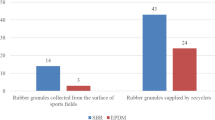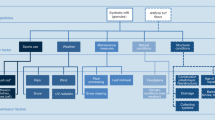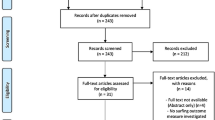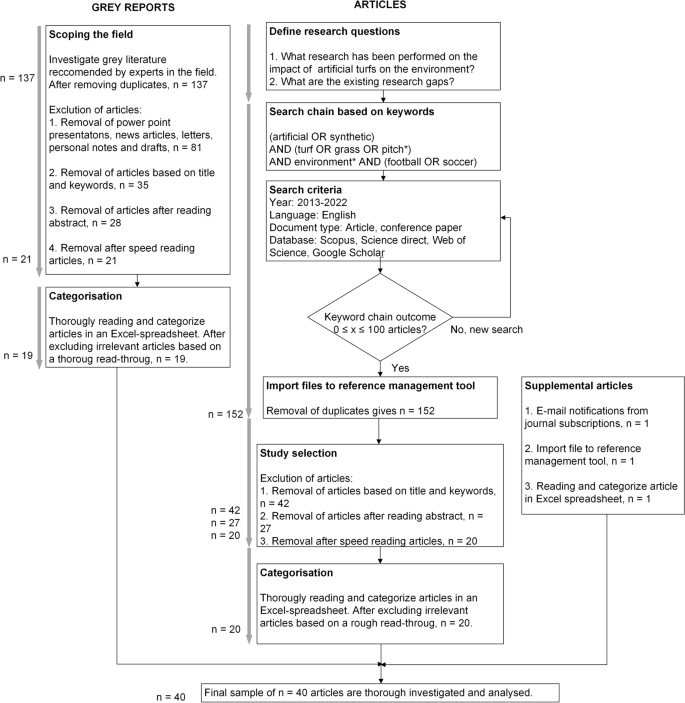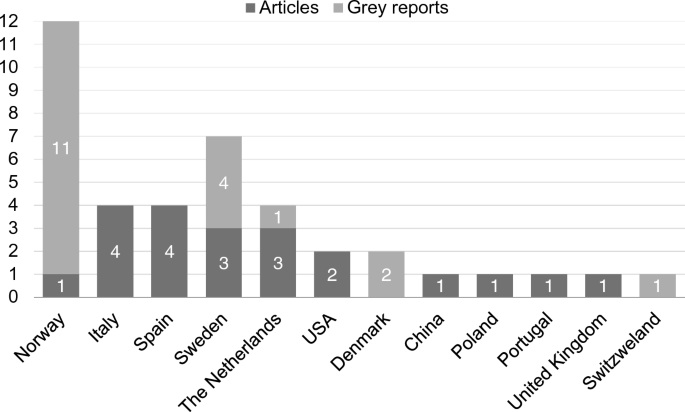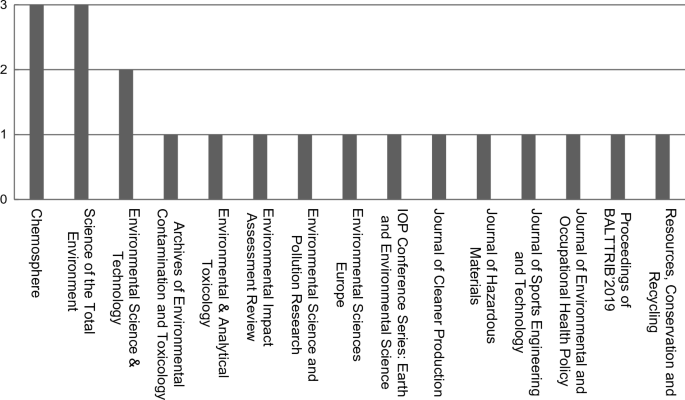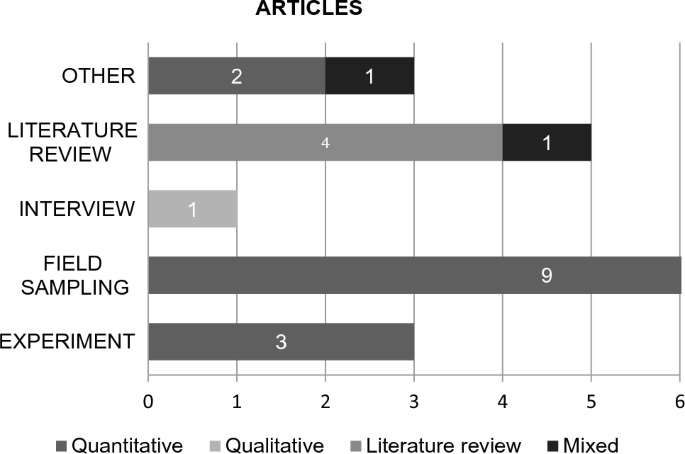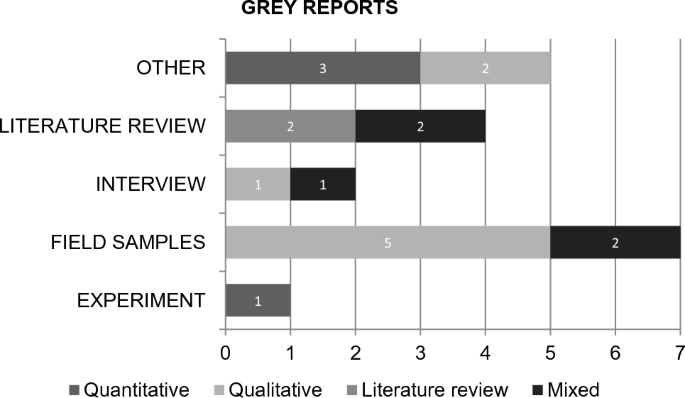Abstract
Artificial turfs represent a large environmental issue in terms of waste, microplastic pollution and leaching of chemicals. Artificial turfs are made of several components, the shock absorbing pad, backing, stabilizing infill, performance infill and artificial grass fibers. Common for these, except the stabilizing infill, is being made of plastic and chemicals being released to the environment. The purpose of this article is to investigate current research on the environmental impact of artificial turfs for football fields. This is done by presenting the state-of-the-art through a review of 40 articles and grey reports. Studies concerning the chemical content of rubber granules and microplastics lost to the environment represent most of the findings. The methods applied vary to a great extent, and more research is needed to further understand the environmental impact of artificial turfs. This study provides an overview of the previous work performed and highlights knowledge gaps and will be of help during further research on the environmental impacts of artificial turfs.
Similar content being viewed by others
Avoid common mistakes on your manuscript.
Introduction
With more than 265 million registered players, football (soccer) is one of the most popular sports worldwide (Federation Internationale de Football Association 2007). Football is often played on artificial turfs, especially in areas with harsh winters (i.e. Scandinavian countries), as they are all-weather play (Larsen et al. 2015). Artificial turfs are typically made of an underlying shock absorbing pad, synthetic green grass fibers, a stabilizing infill (quartz sand) to keep the turf in place, and a performance infill (e.g. styrene-butadiene rubber (SBR) granules from end-of-life tires) to ensure playability of the field (Larsen et al. 2015). SBR is currently the preferred infill type (KG2021 2020; Larsen et al. 2015). Artificial turfs represent a significant environmental issue in terms of waste, microplastic pollution and leaching of chemicals (Norwegian Environment Agency, n.d; Norwegian Environmental Agency 2021).
First, artificial turf generate waste in terms of plastics, microplastics, sand and performance infill (Bø et al. 2020; Mørk-Kontny and Mekki 2022). A typical 11-a-side football field is 6400 m2 and weighs approximately 225 tons, holding a lifetime of 10–12 years (Larsen et al. 2015; Mørk-Kontny and Mekki 2022; NFF 2021). In Norway, expected amounts of waste are 26,900 tons/year, were 52% is plastic waste (Mørk-Kontny and Mekki 2022). Ongoing recycling initiatives, such as Re-Match or TeBe Sport, provide the opportunity of recycling and reusing materials, which reduces waste.
Second, artificial turfs are assumed to be the second largest land-based source of microplastics (plastics < 5 mm in size) released to the environment (Norwegian Environment Agency, n.d). It is estimated an annual loss of 16,000 tons/year to the environment by the European Chemicals Agency (ECHA 2023). Microplastics are released to the environment by the user of the field, use of maintenance equipment, run off to surrounding soil and waters and by snow removal (Forskningskampanjen 2017; Gustavsen 2019; Korbøl 2018; Lassen et al. 2015; Løkkegaard et al. 2019; Rambøll 2017; Regnell 2017; Tandeberg and Raabe 2017). Restrictions and regulations of intentionally added microplastics in artificial turfs are pursued on both a domestic level of individual nations and within the European Union (ECHA 2021, n.d; Forurensningsforskriften). This is done to prevent further loss to the environment (ECHA 2021, n.d; Forurensningsforskriften).
Third, the manufacturing process to produce artificial turfs requires large amounts of water, energy, and non-renewable petroleum-based materials (e.g., polyethylene) to make the turf. CO2-emissions from artificial turfs occur during manufacturing, production, transportation, installation, maintenance and at end of life (e.g., incineration of fields) (FIFA 2017).
Last, installing artificial turf will have an impact on the local environment. Research show that the use of specific types of performance infill lead to leaching of heavy metals (e.g., Zinc) and polycyclic aromatic hydrocarbons (PAHs) (Berger 2021; Celeiro et al. 2021b; Cheng et al. 2014; Marsili et al. 2015; Rabben 2020).
Research questions and structure of study
To investigate current research on the environmental impact of artificial turfs, a scoping review methodology is carried out, following Arksey and O'Malley (2005). This study addresses the following two research questions:
-
1.
What research has been performed on the impact of artificial turf on the environment?
-
2.
What are the existing research gaps?
In the following, the methodology of the scoping review is presented in “Materials and methods” section. Results from the analysis of studies are presented in “Results and discussions” section. The discussion in “Conclusions” section follows the same structure as the presented results. Finally, in Sect. 5, the two research questions are addressed and suggestions for further research is provided. The scoping review was carried out in Norway in 2023.
Materials and methods
A scoping review methodology is utilized, following the five guidelines provided by Arksey and O'Malley (2005) These five stages are visualized in the flow-chart in Fig. 1.
Scoping the field: grey literature
Before beginning the scoping review, a total of 137 grey literature publications recommended by experts in the field were investigated. One expert has collected grey literature for the last ten years while working with sports facilities, and the second expert is an industry contact. Both are from Norway. No separate search for grey literature has been carried out. First, power point presentations, news articles, letters and personal notes and drafts were removed, reducing to 81 grey reports. Further exclusion of grey publications was made by first reading the title and keywords, resulting in a reduction to a sample of 35. Then, by reading abstracts the sample was further reduced to 28. After speed-reading the publications entirely, the sample was decreased to 21. Last, after a thorough readthrough, a final sample of 19 was kept for further investigations. Articles were excluded if they did not align with research question 1: What research has been performed on the impact of artificial turfs on the environment? An overview of the exclusion criteria is found in Table 1.
Identifying studies: research publications
Based on the research question, search terms and synonyms for each term were identified. A search string based on keywords was found to be: (artificial OR synthetic) AND (turf OR grass OR pitch*) AND environment* AND (football OR soccer). Search criteria were set to be English scientific articles or conference papers, published between 2013 and 2022. The reason for this was the building of artificial turfs started in full force in the beginning of the 2010s and environmental concerns of artificial turfs was raised in the end of 2010s (Mørk-Kontny and Mekki 2022). The following scientific databases/search portals were used: Scopus, Science direct, Web of Science, and Google Scholar. The software Publish or Perish was utilized to aid the search in Google Scholar (Harzing 2007). The search was limited to a maximum of 100 most top cited. The software retrieves both articles and non-articles, where the non-articles were removed manually. To include research being published while the scoping review was performed, an e-mail notification was put up in all databases (except Google Scholar) to get notified if articles were published on the same search chain of keywords. The e-mail push-notification resulted in 1 article (Kole et al. 2023).
When a search generated less than one hundred and more than zero, they were imported to the reference management tool End Note (Clarivate 2023). After retrieving articles from all databases, removal of duplicates was performed. A total of 152 articles were retrieved.
Selection of studies
The exclusion of articles was done in three steps. First, exclusion was done by eliminating articles based on reading their title and keywords. This resulted in a reduction to 42 articles. If title and keywords were relevant, the abstract was read. This further diminished the selection of articles to 27. Last, if the abstract seemed relevant, the article was roughly read through. Articles were excluded if they were found to be out of the scope or if they were irrelevant based on the first research question. This last step resulted in 20 articles. Final exclusion criteria are presented in Table 2.
Charting the data
A total of 40 articles, grey reports (19) and articles (21) were categorized. This process was done simultaneously for the grey reports and the articles. Categorization of the was done in an Excel-spread sheet. The title and publication year of the article was retrieved. In addition, the name of journal where the article was published, name of first and last author, geographical affiliation of first and last author was noted. Notes on the aim, method, results, area of focus, and implication of study were collected from the articles abstract.
Results and discussions
Results
The following section outlines findings from the scoping review process. No articles from earlier than 2013 were collected from the database search, and no grey reports published before 2015 were recommended. Therefore, the trend line of publications per year is not presented.
Geographical affiliation
In Fig. 2, the geographical affiliation of the first author is represented. Twelve countries are represented. 54% of studies geographical affiliation from Scandinavia and 90% from Europe. Only three articles are affiliated outside Europe: two in USA (Massey et al. 2020; Pochron et al. 2017) and one in China (Cheng et al. 2014).
Scientific journals
In Fig. 3, the scientific journals are visualized. Investigation of what scientific journals the reviewed articles are published in, reveals a wide range of journals utilized. Fifteen different journals have accepted twenty articles. Seven out of twenty are published in three journals, where Chemosphere (Celeiro et al. 2021b, 2018; Pochron et al. 2017) and Science of the Total environment (Armada et al. 2022; Celeiro et al. 2021a; Kole et al. 2023) are most frequently used.
Methods utilized in articles and grey reports
The methods utilized are divided into quantitative, qualitative, mixed method (where both a quantitative and qualitative approach has been performed), and literature review. Specific methods are noted and elaborated in the following subsections. In studies were more than one method is utilized, their main method is visualized in Figs. 4 and 5.
The most utilized method for both articles and grey reports was field sampling (Armada et al. 2022; Berger 2021; Brandsma et al. 2019; Celeiro et al. 2021a, b; Celeiro et al. 2018; Grynkiewicz-Bylina et al. 2022; Haave 2018; Haave et al. 2022; Korbøl 2018; Marsili et al. 2015; Rabben 2020; Regnell 2017; Ruffino et al. 2013; Schilirò et al. 2013; Tandeberg and Raabe 2017). There were nine articles using field sampling as main method, all of them quantitative, then complimented with a chemical analysis to determine the presence or release of PAHs, heavy metals, volatile organic compounds (VOC), and/or chlorinated paraffins in samples, or air pollution (Armada et al. 2022; Brandsma et al. 2019; Celeiro et al. 2021a, b; Celeiro et al. 2018; Grynkiewicz-Bylina et al. 2022; Marsili et al. 2015; Ruffino et al. 2013; Schilirò et al. 2013). Seven grey reports utilized field sampling as their main method (Berger 2021; Haave 2018; Haave et al. 2022; Korbøl 2018; Rabben 2020; Regnell 2017; Tandeberg and Raabe 2017). Five focused on investigating the release of microplastics to the environment, either to water or soil (Haave 2018; Haave et al. 2022; Korbøl 2018; Regnell 2017; Tandeberg and Raabe 2017). Two studies took field samples from water and soil to identify the presence of heavy metals (Berger 2021; Rabben 2020).
Experiments
Three articles use an experimental set up to investigate respectively the soil contamination of heavy metals, air pollution by rubber granules, and how the pitch degrades and microplastic lost to the environment (Fleming et al. 2020; Olofsson and Lyu 2019; Pochron et al. 2017). One study ran a 34-day experiment on 100 earthworms in soil contaminated with crumb-rubber (Pochron et al. 2017). The second used a pendulum rig to investigate the transmission of a migration of particles from artificial turfs (Olofsson and Lyu 2019). And the last experimented with maintenance interventions, to get a deeper understanding of the mechanisms how the turf degrades and quantifying the effects of intervention, in addition a database of 750 turfs was investigated (Fleming et al. 2020).
One grey report used a large-scale experiment, where 12,000 participants played 2 × 15 min games, then collecting all rubber granules stuck to their clothes. This was to investigate microplastic loss to the environment by users of the field (Forskningskampanjen 2017).
Interviews
One article use semi-structured interview as method, in addition to document analysis and an open-ended questionnaire, to investigate barriers for sustainable practices within the artificial turf industry (de Bernardi and Waller 2022). Two grey reports use interviews with experts in the field and industry leaders, or municipalities, as their main method (Krång et al. 2019; Mørk-Kontny and Mekki 2022). The interviews are categorized as both structured (Krång et al. 2019) and unstructured (Mørk-Kontny and Mekki 2022), both aiming to increase the knowledge of microplastics lost from artificial turfs to the environment.
Literature review
Literature review is used by five articles as the main method, to understand the environmental impact of PAHs, VOCs, and heavy metals (Cheng et al. 2014; Gomes et al. 2021; Massey et al. 2020), microplastics (Kole et al. 2023; Verschoor et al. 2021). One reviewed published articles, books, and grey literature (Cheng et al. 2014). The second article reviews grey reports on microplastics from artificial turfs lost to the environment (Verschoor et al. 2021). Neither states the method of how the literature review was performed. The third investigates 72 articles on potentially harmful chemicals in SBR rubber granules (Gomes et al. 2021). The third literature review investigates government agency reports and peer-reviewed studies to complement their chemical analysis of different performance infill types (Massey et al. 2020). The last estimates mitigation of microplastics from the fields by a systematic review. (Kole et al. 2023).
Four grey reports investigate microplastic loss to the environment by literature review as main method (Lassen et al. 2015; Sundt et al. 2016; Verschoor and Werner 2017; Wallberg et al. 2016). None describe their methodology. Three reports include their data sources (Lassen et al. 2015; Verschoor and Werner 2017; Wallberg et al. 2016).
Other
Three articles have been categorized as “other” in their methods. Research on the life cycle of an artificial turf with SBR as performance infill and compare it to a natural turf has been done (Russo et al. 2022). This was done by a product environmental footprint approach, based on a life cycle assessment (LCA)-method (Russo et al. 2022). LCA-methodology is also used to investigate greenhouse gas emissions and energy consumption from artificial turfs (Magnusson and Mácsik 2017). One study utilizes a material flow analysis (MFA) of Norwegian artificial turfs roughly estimate SBR lost to the environment annually (Bø et al. 2020).
Five grey reports fall under the “other” category and consist of both quantitative and qualitative studies. One larger survey (n = 253) maps maintenance, operation, design, and location of artificial turfs in Norway (Rambøll 2017). A mapping of microplastics released to the environment has been performed by observation of 42 artificial turfs (Gustavsen 2019). In 2019, a case study of an artificial turf in Kalmar in Sweden was published, investigating how minimal the release of microplastics can be if right measurements are implemented (Regnell 2019). A document/database-study was done by Fédération Internationale de Football Association (FIFA) to investigate the environmental impact of artificial turfs in their database (FIFA 2017) Last, an MFA was done to quantify release of microplastics from artificial turfs to the aquatic environment (Løkkegaard et al. 2019).
Chemicals in artificial turfs
SBR is the most utilized performance infill in artificial turf. As they are made from end-of-life tires, they could potentially contain PAHs and VOCs, semi-volatile organic hydrocarbons (SVOCs), heavy metals, or phthalates (ECHA 2017). Research found that these chemicals can be released to the environment and could represent a risk to the environment, and risk assessment should be performed for all performance infill types (Magnusson and Mácsik 2017).
By performing a hazard-based analysis of a wide range of performance infill used for artificial turfs, a conclusion was reached that none of the performance infill types used for artificial turfs are completely free from concerns relating to the environment (Massey et al. 2020).
The presence of PAHs and VOCs from rubber granules has been identified and assessed in several studies by different chemical analysis (Armada et al. 2022; Celeiro et al. 2021a, b; Celeiro et al. 2018; Marsili et al. 2015). From investigating 91 infill samples from 17 countries and 4 continents, a worldwide confirmation was done of the presence of PAHs in rubber granules from artificial turfs (Armada et al. 2022). PAHs and VOCs are present in almost every tested infill type, except shoe materials, acrylic-coated sand and mineral- or plant-based types (Massey et al. 2020). Alternative infill types, such as cork, do not contain PAHs and are suggested as a safer and more sustainable alternative to rubber granules for artificial turfs (Armada et al. 2022; Celeiro et al. 2021a).
PAHs leaching to the environment can occur and represents a potential risk for the aquatic environment (Celeiro et al. 2021b, 2018; Marsili et al. 2015). It is argued that SBR does not represent an environmental risk based on the quantities of PAHs leaching to the environment being scarce (Grynkiewicz-Bylina et al. 2022). It is still important to consider the size and classification of SBR, as they are microplastics, in relation to environmental aspects. New applications of the material should be considered (Grynkiewicz-Bylina et al. 2022). Non-plastic infill is recommended as microplastics are an environmental concern (Armada et al. 2022).
SBR samples exhibit a significant presence of high concentrations of heavy metals (Celeiro et al. 2018; Gomes et al. 2021; Marsili et al. 2015). Leaching of these heavy metals occurs and ends up in the surrounding environment (Gomes et al. 2021; Grynkiewicz-Bylina et al. 2022; Marsili et al. 2015). As the particle size of SBR decreases, the leaching of heavy metals increases (Cheng et al. 2014). This leaching, except Zinc, is found to be low and not to cause concern (Marsili et al. 2015; Pochron et al. 2017). Though, some studies put attention to the number of heavy metals leaching into the environment, especially Zinc, Ni and Cr, as an increased amount will enhance the ecotoxicity, and could affect the life of plants and animals close to the turf (Cheng et al. 2014; Gomes et al. 2021). A high leaching potential of Zinc from artificial turfs with SBR is found, but it is argued that due to the dilution that will occur it does not represent an environmental risk (Berger 2021). Larger amounts of ground contaminated with Zinc accumulating in the soil have been found where snow contaminated with rubber granules has been stored during winter (Rabben 2020).
Chlorinated paraffins have been identified in rubber granules. Further investigation of the leaching from rubber granules should be done, to better understand mitigation and leaching mechanisms of rubber granules and their impact on the environment (Brandsma et al. 2019).
Sustainability of artificial turfs
Research implies that fine dust of rubber granules, PAHs, VOCs, and other organic substances can pollute the air, but are found to comply with regulations (Celeiro et al. 2018; Cheng et al. 2014; Marsili et al. 2015). Performance infill of ethylene propylene diene monomer rubber (EPDM), compared to SBR and thermo plastic elastomers (TPE), generates more airborne particles (Olofsson and Lyu 2019). When comparing the exposure risks of PAHs through air, artificial turfs do not represent any larger environmental risks than comparing to the surrounding city in urban areas (Ruffino et al. 2013; Schilirò et al. 2013). Outdoor facilities have a lower concentration of PAHs, compared to indoor facilities (Celeiro et al. 2021a; Gomes et al. 2021).
The carbon footprint of a 9000 m2 artificial turf with a 10-year lifetime (including manufacturing, transportation, installation, maintaining and disposing) is estimated to be 55.6 t/CO2, around 3 times more than a natural turf of the same size (Cheng et al. 2014). If it is impossible to recover the artificial turf at end-of-life, CO2-emissions could double (Cheng et al. 2014). A key to improve the sustainability of artificial turfs is to enhance the recovery technology (FIFA 2017; Russo et al. 2022).
According to Magnusson and Mácsik (2017), when performing an LCA-analysis of artificial turfs, it is seen that the greenhouse gas-emissions significantly correlates with materials, maintenance and removal of turf. GHG-emissions are larger with TPE as performance infill, than EPDM, and reuse of materials can potentially decrease emissions and energy use (Magnusson and Mácsik 2017).
There are barriers actors have to overcome to enhance the environmental sustainability of their artificial turfs (de Bernardi and Waller 2022). A good dialogue, good information flow and education regarding environmental sustainability of artificial turfs is one of the obstacles. To improve the sustainability of turfs, a standardization of the procurement process have been suggested, in addition to enhancing the maintenance practice to ensure longer viability of artificial turfs and reduce waste (de Bernardi and Waller 2022).
Release of microplastics to the environment
Microplastics will be lost from artificial turfs to the environment (Bø et al. 2020; Gustavsen 2019; Lassen et al. 2015). This occurs due to the current design, operation, and maintenance of the artificial turfs (Bø et al. 2020). Investigations of loss/year has been carried out (Fleming et al. 2020). Loss of performance infill has been found to be equal to a change in performance infill depth of 0.8 mm/year, after year 3–4 (Fleming et al. 2020). One should carefully implement compaction as a cause for the need for refilling fields as refilling compaction can occur, not solely because they are lost to the surrounding environment (Verschoor et al. 2021). A significant amount of research identifying microplastic loss has been carried out. The amount of microplastics lost to the environment varies from turf to turf and from country to country, varying from 0.0001 to 5 tons/year/field (Bø et al. 2020; Haave 2018; Haave et al. 2022; Kole et al. 2023; Lassen et al. 2015; Løkkegaard et al. 2019; Rambøll 2017; Regnell 2017, 2019; Sundt et al. 2016; Tandeberg and Raabe 2017; Verschoor et al. 2021; Wallberg et al. 2016).
There are numerous routes where microplastics can enter the environment surrounding the artificial turf: By the players using the field, use of maintenance equipment, run off to the surrounding soil and waters and by snow removal (Forskningskampanjen 2017; Haave et al. 2022; Korbøl 2018; Løkkegaard et al. 2019; Rambøll 2017; Regnell 2017, 2019). The loss found outside fields decreases with distance to the turf (Haave 2018).
Best practices
FIFA states that the choice of infill material used should be considered as a means to mitigate the environmental impact of artificial turfs (FIFA 2017). Organic infills have the lowest impact on the environment, compared to infills of polymers (FIFA 2017). By using a shock pad the environmental impact will be reduced (FIFA 2017).
In addition to improving the turf design, microplastic loss can be reduced to as little as 0.1 kg/field/year by implementing “best practices” for how the artificial turf should be used and maintained (Regnell 2019). This could for example be to implement a fence around the field or implement a surface for snow storage during winter (Regnell 2019). Implementing measures will effectively reduce microplastic loss to the environment (Haave et al. 2022). Some municipalities are already actively working on reducing microplastic loss by implementing best practices, already have experienced a reduction in loss to the environment (Krång et al. 2019). Lack of knowledge, resources, and regulations about best practice, in addition to the turf design, are stated as barriers to actively reduce microplastic loss (Rambøll 2017).
In Norway, according to Mørk-Kontny and Mekki (2022), the expected amounts of waste generated in the period 2020–2045 is expected to be 26,900 tons/year (33,100 tons every 12 year). The recycling facilities separate sand and rubber granules from the turf. If the components are of good quality, they will be used (FIFA 2017; Mørk-Kontny and Mekki 2022). If the turf is too worn and cannot be further utilized in other areas, it is material or energy recovered, or landfilled (Mørk-Kontny and Mekki 2022). A full closed loop-process of handling artificial turfs at their end-of-life is still being developed (FIFA 2017).
Discussion
This paper has addressed what research has been performed on the impact of artificial turf on the environment and what are the existing research gaps. In the following, we assess these questions separately, before providing an outline of how the limitations of the study have influenced the analysis.
Research performed on the impact of artificial turfs on the environment
The studies found in this scoping review are investigating artificial turf fields made of synthetic grass fibers with SBR used as performance infill, utilized for recreational football. In addition, a few studies investigate turfs using newer alternatives to performance infill, such as cork/coconut, crushed olive pits or sand (Armada et al. 2022; Celeiro et al. 2018; FIFA 2017). Alternative types of performance infill are a fairly new field of study, as SBR has been the preferred infill type since the 1990s (KG2021 2020).
An interesting observation, that cannot be generalized due to the small sample size, is that the most prominent countries in research on environmental impact of artificial turfs are from Scandinavia (21). In sum, 35 studies are conducted in Europe. First, this could be due to the regulations introduced on a national level in the individual countries or ECHAs regulation on PAHs in artificial turfs, or the European Green Deal with an initiative of addressing microplastics in the environment (ECHA 2021, n.d; Forurensningsforskriften). Second, artificial turfs in an environmental setting might be a “new” field of study and is less researched in other countries outside Europe. Last, the recommended grey report could be biased by the expert’s background being Scandinavian.
When investigating the studies performed, there is no methodological approach standing out. As many studies have the same main topic, i.e., microplastic lost to the environment, their method utilized vary greatly (e.g., field sampling (16), experiments (4), literature reviews (9), interviews (3), survey (1), case study (1), observation (1) and document study (1)). Differences in methodology, contextual differences, and lack of standardization renders comparison of results challenging. A variation on utilized methods has the advantage of data quantity, but consequently inaccuracy in data quality.
Most articles in the sample utilize one main method (e.g. Bø et al. 2020; Cheng et al. 2014; Marsili et al. 2015; Pochron et al. 2017; Ruffino et al. 2013; Schilirò et al. 2013; Verschoor et al. 2021)), while grey reports often combine methods (e.g. Gustavsen 2019; Krång et al. 2019; Mørk-Kontny and Mekki 2022; Rabben 2020; Regnell 2017, 2019; Sundt et al. 2016; Tandeberg and Raabe 2017; Wallberg et al. 2016)).
Field sampling and analysis of these to identify chemical composition or content of microplastics is the most used method (Armada et al. 2022; Berger 2021; Brandsma et al. 2019; Celeiro et al. 2021a, b; Celeiro et al. 2018; Grynkiewicz-Bylina et al. 2022; Haave 2018; Haave et al. 2022; Korbøl 2018; Marsili et al. 2015; Rabben 2020; Regnell 2017; Ruffino et al. 2013; Schilirò et al. 2013; Tandeberg and Raabe 2017). Field sampling gives the opportunity to obtain samples from many different locations and areas on the turf, though challenging to generalize.
Literature reviews are frequently utilized to summarize existing knowledge of impact on the environment (Cheng et al. 2014; Gomes et al. 2021; Lassen et al. 2015; Massey et al. 2020; Sundt et al. 2016; Verschoor et al. 2021; Verschoor and Werner 2017; Wallberg et al. 2016). The literature reviews in the sample are lacking transparency in their methodology, as the majority fail to elucidate data retrieval and analysis (e.g. Lassen et al. 2015; Verschoor and Werner 2017; Wallberg et al. 2016)). Three studies use unstructured, semi-structured and structured interviews to get a better understanding, identify key-issues and feedback from individuals possessing expertise and knowledge of the environmental impact of artificial turf in addition to compliment quantitative data (de Bernardi and Waller 2022; Krång et al. 2019; Mørk-Kontny and Mekki 2022).
Some studies provide a “flow chart” to support field sampling or literature review (Løkkegaard et al. 2019; Regnell 2017; Tandeberg and Raabe 2017; Verschoor et al. 2021; Wallberg et al. 2016). These “flow charts” are called MFA. No proper MFA-methodology, however, is identified (e.g. lack of system boundary and unbalanced flows).
The biggest difference between the published articles and the recommended grey reports is their area of focus. The majority of existing articles concentrates on the content and leaching of PAH, VOCs, and heavy metals from SBR into the surrounding environment, as well as air pollution and GHG-emissions (Armada et al. 2022; Brandsma et al. 2019; Celeiro et al. 2021a, b; Celeiro et al. 2018; Cheng et al. 2014; de Bernardi and Waller 2022; Gomes et al. 2021; Grynkiewicz-Bylina et al. 2022; Magnusson and Mácsik 2017; Marsili et al. 2015; Massey et al. 2020; Olofsson and Lyu 2019; Pochron et al. 2017; Ruffino et al. 2013; Russo et al. 2022; Schilirò et al. 2013). Conversely, grey reports primarily explore the loss of microplastics to the environment (Forskningskampanjen 2017; Gustavsen 2019; Haave 2018; Haave et al. 2022; Korbøl 2018; Krång et al. 2019; Larsen et al. 2015; Lassen et al. 2015; Løkkegaard et al. 2019; Mørk-Kontny and Mekki 2022; Rambøll 2017; Regnell 2017, 2019; Sundt et al. 2016; Tandeberg and Raabe 2017; Verschoor and Werner 2017; Wallberg et al. 2016). Grey reports (17) and articles (4) state that loss of microplastics in the form of rubber granules occur (Bø et al. 2020; Fleming et al. 2020; Forskningskampanjen 2017; Gustavsen 2019; Haave 2018; Haave et al. 2022; Korbøl 2018; Krång et al. 2019; Lassen et al. 2015; Løkkegaard et al. 2019; Mørk-Kontny and Mekki 2022; Rabben 2020; Rambøll 2017; Regnell 2017, 2019; Sundt et al. 2016; Tandeberg and Raabe 2017; Verschoor et al. 2021; Verschoor and Werner 2017; Wallberg et al. 2016). The amount lost varying from 0.0001 to 5 tons/year/field (Bø et al. 2020; Haave 2018; Haave et al. 2022; Lassen et al. 2015; Løkkegaard et al. 2019; Rambøll 2017; Regnell 2017, 2019; Sundt et al. 2016; Tandeberg and Raabe 2017; Verschoor et al. 2021; Wallberg et al. 2016). Loss can happen through several paths, by the user of the field, maintenance of the field, snow removal and run off to surrounding soil and waters (e.g. Bø et al. 2020; Fleming et al. 2020; Forskningskampanjen 2017; Korbøl 2018; Regnell 2019; Verschoor et al. 2021)). As microplastics represents an incredible environmental issue some best practices are suggested (de Bernardi and Waller 2022; FIFA 2017; Haave et al. 2022; Krång et al. 2019; Regnell 2019).
Research gaps
While scoping the field, 40 relevant studies were retrieved from a sample of 290 studies (153 articles and 137 grey reports). On the basis of the exclusion criteria (Tables 1, 2), a subset of 78 studies (72 articles, 6 grey reports) were deemed irrelevant due their focus on artificial turfs impact on human health, injuries and biomechanics. Research gaps found in this study are influenced by the nature of its scope, as it is limited to literature on the environmental impacts of artificial turfs. By addressing the following areas of research, a more comprehensive understanding of the environmental impact of artificial turfs can be found. In particular, themes related to end-of-life options, regulatory changes, flow analysis, carbon footprint, and lifetime concerns, including termination.
First, artificial turfs have a lifetime of 10–12 years (Larsen et al. 2015; Mørk-Kontny and Mekki 2022; NFF 2021). Research has been performed on the amounts of annual waste amounts from artificial turfs, but limited research is found on efficient recycling methods or sustainable end-of-life options (Bø et al. 2020; FIFA 2017; Mørk-Kontny and Mekki 2022).
Second, the loss of microplastics is researched from different perspectives, from loss by the users of the fields to case study of the optimal design of an artificial turf to reduce loss (Bø et al. 2020; Fleming et al. 2020; Forskningskampanjen 2017; Haave 2018; Haave et al. 2022; Korbøl 2018; Krång et al. 2019; Lassen et al. 2015; Løkkegaard et al. 2019; Rambøll 2017; Regnell 2017, 2019; Sundt et al. 2016; Tandeberg and Raabe 2017; Verschoor et al. 2021; Verschoor and Werner 2017; Wallberg et al. 2016). Loss off microplastic is stated to occur, but no standardized method for quantifying loss has been utilized or developed. There are few studies on the design (e.g., alternative performance infill materials), maintenance, and operation of artificial turfs to minimize microplastics lost to the environment in the sample (Bø et al. 2020; FIFA 2017; Regnell 2019). Existing knowledge on the efficiency of regulations or methods for preventing microplastic loss is limited.
Surprisingly, only a single study is found in the sample discussing the current EU policy to ban rubber granules (Verschoor et al. 2021). The study stated as a worst-case scenario, the policy is deemed ineffective and potentially without value (Verschoor et al. 2021). Research addressing regulations and policies implemented on a national and international level is lacking coverage, and could be of value for decision-makers, municipalities and owners of sports facilities.
Third, incorporation of LCAs and MFAs to enhance the understanding of circularity, flows, stocks, resource consumption, GHG-emissions, energy- or water consumption remains limited in the sample (Bø et al. 2020; Løkkegaard et al. 2019; Magnusson and Mácsik 2017; Russo et al. 2022). The MFAs in the sample investigate artificial turfs with performance infill containing polymer, but studies including alternative performance infill materials (e.g., coconut or granulated olive cores) are scarce.
Last, the environmental impact of chemicals from SBR as performance infill has been investigated and reveals leaching of heavy metals (e.g., Zinc) and PAHs to the surrounding soil and air (Berger 2021; Celeiro et al. 2021b; Cheng et al. 2014; Marsili et al. 2015; Rabben 2020). Comprehensive chemical analysis of the artificial turf, leaching behavior and mechanisms, risk assessments, and the effect of aging and weathering, especially for alternative performance infill, are still lacking.
Limitations
First, grey article publications recommended by experts in the field could be influenced by the current discussion on the release of microplastics from artificial turf fields. The recommended grey report could be biased by the expert’s background being Scandinavia. Articles could be left out from their recommendation, though they thematically are within the scope of this study. Second, when comparing a classic systematic review with a scoping review, the latter is a less rigid approach. This gives the scoping review-method flexibility for a rapid search. Third, all articles are English and most of the grey reports are in Scandinavian (15). One would believe that great football nations such as Italy, Spain, France, Germany, or Brazil are publishing research on the topic, but in their language. Thus, knowledge in other languages could be omitted. Fourth, this scoping review study is limited in time. This means that new articles and grey reports may be published at any time and could be missed or overlooked. If reproducing this work, because of time being a limiting factor, one could have a larger selection of studies in the future. Last, this scoping review aims to provide an overview of the current knowledge and gaps, it does not evaluate the quality or the causes of the presented results.
Conclusion
This study has highlighted substantial environmental consequences of using artificial turfs; at the same time little research that focuses specifically on these consequences has been found.
Research performed on the impact of artificial turfs on the environment
In the last decade, 40 studies have been identified on the environmental impact of artificial turfs, and this scoping review reveals a wide range of methods utilized and multiplicity of topics connected to the environmental impact. Research has been found on artificial turfs used for recreational sports. Most of the studies investigate SBR from car tires, and their content of different chemicals and heavy metals that could affect the surrounding environment. A few studies investigate airborne particles polluting the air, where outdoor turfs are less polluted than indoor facilities. Materials utilized in artificial turf and how it is handled at end of life will greatly impact emissions and energy use. Most grey reports investigate loss of microplastics. They are lost to the environment surrounding the artificial turfs. It is hard to estimate how much is lost annually from each turf, as this varies with the turf’s location, facility design, use, maintenance, snow removal and run off.
Research gaps
First, there is no standardized method in assessing the artificial turf’s environmental impact. Methods used in the sample vary giving the advantage of data quantity and inaccuracy in data quality. Second, it is worth noticing that 90% of the studies included were conducted within Europe. Third, LCAs and MFAs would increase the understanding of the circularity, materials, flows, and stocks of artificial turfs. In addition, studies on waste-management and sustainable end-of-life options, or recovery technologies, for artificial turfs would contribute to the field. Research on regulations and policies implemented on a national and international level would possibly be beneficial for decision-makers, municipalities, and owners of sports facilities. Last, research should include comprehensive chemical analysis including, but not limited to, leaching mechanisms, risk assessments and the effect of aging and weathering.
Implications
In practical terms, the findings suggest that urban planners and managers of sports facilities should consider emissions of airborne particles, leaching of heavy metals and loss of microplastics, when renovating or building new artificial turfs. Materials utilized should be carefully chosen (e.g. follow current regulations reduce microplastic emissions (ECHA, n.d)).
Measures have been done in Europe to reduce microplastics added to products (ECHA, n.d). The regulation prohibits sales of microplastics, and products with intentionally added microplastics. It has a transition period of eight years, with an intention on reducing emission of microplastics to the environment (ECHA, n.d). Hence, artificial turfs with SBR and other synthetic polymer particles (< 5 mm in size) is prohibited to be sold after eight years. As artificial turf fields with SBR can be used continuously during and after the transition period, the regulation should be improved to further prevent microplastic emissions. First, facility owners should educate users of the fields about microplastics emissions. Second, facility owners should dispose microplastics that is lost from the field (e.g.due to players, heavy rainfall, or snow removal) in a responsible manner (e.g.return to field or recycling). Last, countries experiencing heavy snow during winter could benefit from having snow deposits, aimed at preventing loss of microplastics during maintenance.
Research on current regulations and policies related to loss of microplastics are lacking coverage and should be prioritized.
References
Arksey H, O’Malley L (2005) Scoping studies: towards a methodological framework. Int J Soc Res Methodol 8(1):19–32. https://doi.org/10.1080/1364557032000119616
Armada D, Llompart M, Celeiro M, Garcia-Castro P, Ratola N, Dagnac T, de Boer J (2022) Global evaluation of the chemical hazard of recycled tire crumb rubber employed on worldwide synthetic turf football pitches. Sci Total Environ 812:152542. https://doi.org/10.1016/j.scitotenv.2021.152542
Berger S (2021) Kartlegging av sinkavrenning fra kunstgressbaner. https://www.godeidrettsanlegg.no/publikasjon/kartlegging-av-sinkavrenning-fra-kunstgressbaner. Accessed 12 June 2023
Brandsma SH, Brits M, Groenewoud QR, van Velzen MJM, Leonards PEG, de Boert J (2019) Chlorinated paraffins in car tires recycled to rubber granulates and playground tiles. Environ Sci Technol 53(13):7595–7603. https://doi.org/10.1021/acs.est.9b01835
Bø SM, Bohne RA, Aas B, Hansen LM (2020) Material flow analysis for Norway’s artificial turfs. IOP Conf Ser Earth Environ Sci. https://doi.org/10.1088/1755-1315/588/4/042068
Celeiro M, Armada D, Dagnac T, de Boer J, Llompart M (2021a) Hazardous compounds in recreational and urban recycled surfaces made from crumb rubber: Compliance with current regulation and future perspectives. Sci Total Environ 755:142566. https://doi.org/10.1016/j.scitotenv.2020.142566
Celeiro M, Armada D, Ratola N, Dagnac T, de Boer J, Llompart M (2021b) Evaluation of chemicals of environmental concern in crumb rubber and water leachates from several types of synthetic turf football pitches. Chemosphere 270:128610. https://doi.org/10.1016/j.chemosphere.2020.128610
Celeiro M, Dagnac T, Llompart M (2018) Determination of priority and other hazardous substances in football fields of synthetic turf by gas chromatography-mass spectrometry: a health and environmental concern. Chemosphere 195:201–211. https://doi.org/10.1016/j.chemosphere.2017.12.063
Cheng H, Hu Y, Reinhard M (2014) Environmental and health impacts of artificial turf: a review. Environ Sci Technol. https://doi.org/10.1021/es4044193
Clarivate (2023). EndNote. https://endnote.com
de Bernardi C, Waller JH (2022) A quest for greener grass: value-action gap in the management of artificial turf pitches in Sweden. J Clean Prod 380:134861. https://doi.org/10.1016/j.jclepro.2022.134861
ECHA (2017) An evaluation of the possible health risks of recycled rubber granules usedas infill in synthetic turf sports fields. https://echa.europa.eu/documents/10162/13563/annexxv_report_rubber_granules_en.pdf/dbcb4ee6-1c65-af35-7a18-f6ac1ac29fe4 Accessed 8 July 2023
ECHA (2021) Opinion related to the request by the Executive Director of ECHA under Art. 77(3)(c) of REACH to prepare a supplementary opinion on: CEN technical report 17519 on risk management measures for artificial pitches and the ESTC study on their effectiveness and the proposed derogation for polymers without carbon atoms in their structure. ECHA/RAC/ A77-O-0000006949–54–01/F. https://echa.europa.eu/documents/10162/17229/art77_3c_mpinfillandnewderogationforpolymers_opi_rac_en.pdf/b85be7e7-c0a8-649a-a0db-56e89e39b3d5?t=1619618145726 Accessed 8 July 2023
ECHA (2023) Granules and mulches on sports pitches and playgrounds. https://echa.europa.eu/hot-topics/granules-mulches-on-pitches-playgrounds Accessed 13 August 2023
ECHA (n.d) Microplastics. from https://echa.europa.eu/hot-topics/microplastics Accessed 3 April 2023
Federation Internationale de Football Association (2007) Big Count: FIFA survey. https://digitalhub.fifa.com/m/77057f201f8021e3/original/bvuzw21jwf0vvlim8ac7-pdf.pdf Accessed 8 August 2023
FIFA (2017) Environmental Impact Study on Artificial Football Turf
Fleming PR, Watts C, Forrester S (2020) A new model of third generation artificial turf degradation, maintenance interventions and benefits. J Sports Eng Technol 234(1):19–33. https://doi.org/10.1177/1754337120961602
Forskningskampanjen (2017) Sjekk kunstgressbanen. https://www.miljolare.no/aktiviteter/kunstgress/rapport. Accessed 18 July 2022
Forskrift om begrensning av forurensning. https://lovdata.no/dokument/SF/forskrift/2004-06-01-931/KAPITTEL_7-6#KAPITTEL_7-6. Accessed 1 July 2022
Gomes FO, Rocha MR, Alves A, Ratola N (2021) A review of potentially harmful chemicals in crumb rubber used in synthetic football pitches. J Hazard Mater 409:124998. https://doi.org/10.1016/j.jhazmat.2020.124998
Grynkiewicz-Bylina B, Rakwic B, Słomka-Słupik B (2022) Tests of rubber granules used as artificial turf for football fields in terms of toxicity to human health and the environment. Sci Rep 12(1):6683. https://doi.org/10.1038/s41598-022-10691-1
Gustavsen, L. (2019). Kunstgressbaner i vannområdet Leira-Nitelva. En undersøkelse av gummigranulat på avveie. https://www.godeidrettsanlegg.no/publikasjon/kunstgressbaner-i-vannomrade-leira-nitelva-en-undersokelse-av-gummigranulat-pa-avveie Accessed 8 July 2023
Harzing AW (2007) Publish or Perish. https://harzing.com/resources/publish-or-perish
Haave M (2018) Preliminær undersøkelse av mikroplast og gummigranulat ved kunstgressbaner. https://www.godeidrettsanlegg.no/sites/default/files/bilder/Preliminaer-undersokelse-mikroplast-gummigranulat-kunstgressbaner-2018.pdf Accessed 18 February 2023
Haave M, Henriksen T, Gomiero A, Bye-Ingebrigsen E (2022) Kartlegging av mikroplastkilder i urbant miljø fra land til sjø - kilder, mengder og spredning
KG2021 (2020) Kunstgressets historie. Gode idrettsanlegg. https://www.godeidrettsanlegg.no/publikasjon/kunstgressets-historie Accessed 18 January 2023
Kole PJ, Van Belleghem FGAJ, Stoorvogel JJ, Ragas AMJ, Löhr AJ (2023) Tyre granulate on the loose; How much escapes the turf? A systematic literature review. Sci Total Environ 903:166221. https://doi.org/10.1016/j.scitotenv.2023.166221
Korbøl O (2018) Microplastics in freshwater sediments: An investigation of stream sediments downstream of artificial football turfs, Norwegian University of Life Sciences
Krång A-S, Olshammar M, Edlund D, Hållén J, Stenfors E, Winberg von Friesen L (2019) Sammanställning av kunskap och åtgärdsförslag för att minska spridning av mikroplast från konstgräsplaner och andra utomhusanläggningar för idrott och lek
Larsen G, Kvalheim G, Halvorsen O, Roa M, Myhrvold O (2015) Veileder: Kunstgressboka https://www.regjeringen.no/no/dokumenter/veileder-kunstgressboka-v-0975-b/id2425810/
Lassen C, Hansen SF, Magnusson K, Hartmann NB, Rehne Jensen P, Nielsen TG, Brinch A (2015) Microplastics: occurrence, effects and sources of releases to the environment in Denmark
Løkkegaard H, Malmgren-Hansen B, Nilsson NH (2019) Massebalancer af gummigranulat, som forsvinder fra kunstgræsbaner: med fokus på utledning til vandmiljøet
Magnusson S, Mácsik J (2017) Analysis of energy use and emissions of greenhouse gases, metals and organic substances from construction materials used for artificial turf. Resour Conserv Recycl. https://doi.org/10.1016/j.resconrec.2017.03.007
Marsili L, Coppola D, Bianchi N, Maltese D, Bianchi M, Fossi MC (2015) Release of polycyclic aromatic hydrocarbons and heavy metals from rubber crumb in synthetic turf fields: preliminary hazard assessment for athletes. J Environ Anal Toxicol 5:265. https://doi.org/10.4172/2161-0525.100026
Massey R, Pollard L, Jacobs M, Onasch J, Harari H (2020) Artificial turf infill: a comparative assessment of chemical contents. New Solut J Environ Occup Health Policy 30(1):10–26. https://doi.org/10.1177/1048291120906206
Mørk-Kontny CF, Mekki M (2022) Kassert kunstgress og plastholdig, løst fyllmateriale M-2414|2022. https://www.miljodirektoratet.no/publikasjoner/2022/desember/kassert-kunstgress-og-plastholdig-lost-fyllmateriale/
NFF (2021) Oversikt anlegg i Norge - Kretsvis oversikt over anlegg i Norge. https://www.fotball.no/klubb-og-leder/anleggsutvikling/oversikt-anlegg-i-norge/. Accessed 01 May 2021
Norwegian Environment Agency (n.d) Mikroplast finnes overalt i naturen. https://miljostatus.miljodirektoratet.no/mikroplast. Accessed 24 May 2023
Norwegian Environmental Agency (2021) Gummigranulat fra kunstgressbaner. https://www.miljodirektoratet.no/ansvarsomrader/avfall/avfallstyper/gummigranulat-fra-kunstgressbaner/. Accessed 02 March 2023
Olofsson U, Lyu Y (2019) A pendulum RIG study on airborne transmission and migration of particles from artificial football turf. In: Proceedings of 10th international scientific conference BALTTRIB 2019
Pochron ST, Fiorenza A, Sperl C, Ledda B, Lawrence Patterson C, Tucker CC, Tucker W, Ho YL, Panico N (2017) The response of earthworms (Eisenia fetida) and soil microbes to the crumb rubber material used in artificial turf fields. Chemosphere. https://doi.org/10.1016/j.chemosphere.2017.01.091
Rabben EL (2020) Tiltaksplan for håndtering av forurenset grunn - Øya kunstgressbane, Malvik
Rambøll (2017) Kartlegging av håndtering av granulat på kunstgressbaner M-954. https://www.miljodirektoratet.no/publikasjoner/2018/januar-2018/kartlegging-av-handtering-av-granulat-pa-kunstgressbaner-2017/
Regnell F (2017) Mikroplaster från Kontgräsplaner. Orsaker till spridning av mikroplaster samt en kvalitativ analyse av spridningen til dränarings- och dagvattenbrunnar Royal Institute of Technology.
Regnell F (2019) Mikroplastspridning från en modernt utformad konstgräsplan med skyddsåtgärder. https://www.ragnsellstyrerecycling.com/globalassets/tyre-company/dokument/rapport---mikroplastspridning-fran-en-modernt-utformad-konstgrasplan-med-skyddsatgarder.pdf
Ruffino B, Fiore S, Zanetti MC (2013) Environmental-sanitary risk analysis procedure applied to artificial turf sports fields. Environ Sci Pollut Res 20(7):4980–4992. https://doi.org/10.1007/s11356-012-1390-2
Russo C, Cappelletti GM, Nicoletti GM (2022) The product environmental footprint approach to compare the environmental performances of artificial and natural turf. Environ Impact Assess Rev 95:106800. https://doi.org/10.1016/j.eiar.2022.10680
Schilirò T, Traversi D, Degan R, Pignata C, Alessandria L, Scozia D, Bono R, Gilli G (2013) Artificial turf football fields: Environmental and mutagenicity assessment. Arch Environ Contam Toxicol 64(1):1–11. https://doi.org/10.1007/s00244-012-9792-1
Sundt P, Skogesal O, Schulze P-E (2016) Primary microplastic: pollution: Measures and reduction potentials in Norway
Tandeberg I, Raabe EB (2017) Kartlegging av gummigranulat-/mikroplastavrenning fra idrettsbaner. https://www.godeidrettsanlegg.no/sites/default/files/bilder/Hovedrapport%20Gummigranulat.pdf
Verschoor AJ, van Gelderen A, Hofstra U (2021) Fate of recycled tyre granulate used on artificial turf. Environ Sci Eur 33:27. https://doi.org/10.1186/s12302-021-00459-1
Verschoor AJ, Werner S (2017) Assessment document of land-based inputs of microplastics in the marine environment
Wallberg P, Keiter S, Andersen TJ, Nordenadler M (2016) Däckmaterial i konstgräsplaner. https://www.sdab.se/media/1120/daeckmaterial_i_konstgraesplaner.pdf
Acknowledgements
The authors would like to thank the two anonymous experts in the field for valuable suggestions on grey reports.
Funding
Open access funding provided by NTNU Norwegian University of Science and Technology (incl St. Olavs Hospital - Trondheim University Hospital). This work is funded by Centre for Sports Facilities and Technology at the Norwegian University of Science and Technology and the Ministry of Culture and Equality in Norway (22/5700-8).
Author information
Authors and Affiliations
Corresponding author
Ethics declarations
Conflict of interest
The authors declare no conflict of interest with respect to the research, authorship, and/or publication of this article.
Additional information
Editorial responsibility: Samareh Mirkia.
Supplementary Information
Below is the link to the electronic supplementary material.
Rights and permissions
Open Access This article is licensed under a Creative Commons Attribution 4.0 International License, which permits use, sharing, adaptation, distribution and reproduction in any medium or format, as long as you give appropriate credit to the original author(s) and the source, provide a link to the Creative Commons licence, and indicate if changes were made. The images or other third party material in this article are included in the article's Creative Commons licence, unless indicated otherwise in a credit line to the material. If material is not included in the article's Creative Commons licence and your intended use is not permitted by statutory regulation or exceeds the permitted use, you will need to obtain permission directly from the copyright holder. To view a copy of this licence, visit http://creativecommons.org/licenses/by/4.0/.
About this article
Cite this article
Bø, S.M., Bohne, R.A. & Lohne, J. Environmental impacts of artificial turf: a scoping review. Int. J. Environ. Sci. Technol. (2024). https://doi.org/10.1007/s13762-024-05689-3
Received:
Revised:
Accepted:
Published:
DOI: https://doi.org/10.1007/s13762-024-05689-3


